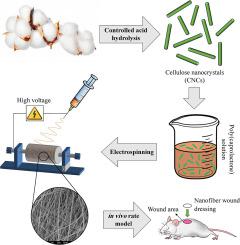Biomaterials Advances ( IF 7.9 ) Pub Date : 2021-01-06 , DOI: 10.1016/j.msec.2020.111855 Ahmad Hivechi , S. Hajir Bahrami , Ronald A. Siegel , Allison Siehr , Anasuya Sahoo , Peiman Brouki Milan , Mohammad Taghi Joghataei , Moein Amoupour , Sara Simorgh

|
Mechanical properties of tissue engineering nanofibrous scaffolds are of importance because they not only determine their ease of application, but also influence the environment for cell growth and proliferation. Cellulose nanocrystals (CNCs) are natural renewable nanoparticles that have been widely used for manipulating nanofibers' mechanical properties. In this article, cellulose nanoparticles were incorporated into poly(caprolactone) (PCL) solution, and composite nanofibers were produced. Ozawa-Flynn-Wall (OFW) methodology and X-ray diffraction were used to investigate the effect of CNC incorporation on PCL crystalline structure and its biological properties. Results showed that CNC incorporation up to 1% increases the crystallization activation energy and reduces the crystal volume, while these factors remain constant above this critical concentration. MTT assay and microscopic images of seeded cells on the nanofiber scaffolds indicated increased cell growth on the samples containing CNC. This behavior could be attributed to their greater hydrophilicity, which was confirmed using parallel exponential kinetics (PEK) model fitting to results obtained from dynamic vapor sorption (DVS) studies. Superior performance of CNC containing samples was also confirmed by in vivo implantation on full-thickness wounds. The wound area faded away more rapidly in these samples. H&E and Masson's trichrome staining showed better regeneration and more developed tissues in wounds treated with PCL-CNC1% nanofibers.
中文翻译:

纤维素纳米晶体对电纺聚己内酯结晶动力学和生物学特性的影响
组织工程纳米纤维支架的机械性能非常重要,因为它们不仅决定其易用性,而且还会影响细胞生长和增殖的环境。纤维素纳米晶体(CNC)是天然的可再生纳米颗粒,已被广泛用于操纵纳米纤维的机械性能。在本文中,将纤维素纳米颗粒掺入聚己内酯(PCL)溶液中,并生产出复合纳米纤维。Ozawa-Flynn-Wall(OFW)方法和X射线衍射用于研究CNC掺入对PCL晶体结构及其生物学特性的影响。结果表明,最多掺入1%的CNC会增加结晶活化能并减小晶体体积,而这些因素在此临界浓度以上保持恒定。MTT分析和纳米纤维支架上的种子细胞的显微图像表明,含有CNC的样品的细胞生长增加。此行为可归因于其更大的亲水性,这可以通过使用平行指数动力学(PEK)模型拟合动态蒸汽吸附(DVS)研究获得的结果来证实。CNC样品的优越性能也得到了以下方面的证实:在全层伤口上进行体内植入。在这些样品中,伤口区域消失得更快。H&E和Masson的三色染色在用PCL-CNC1%纳米纤维处理的伤口中显示出更好的再生和更发达的组织。


























 京公网安备 11010802027423号
京公网安备 11010802027423号